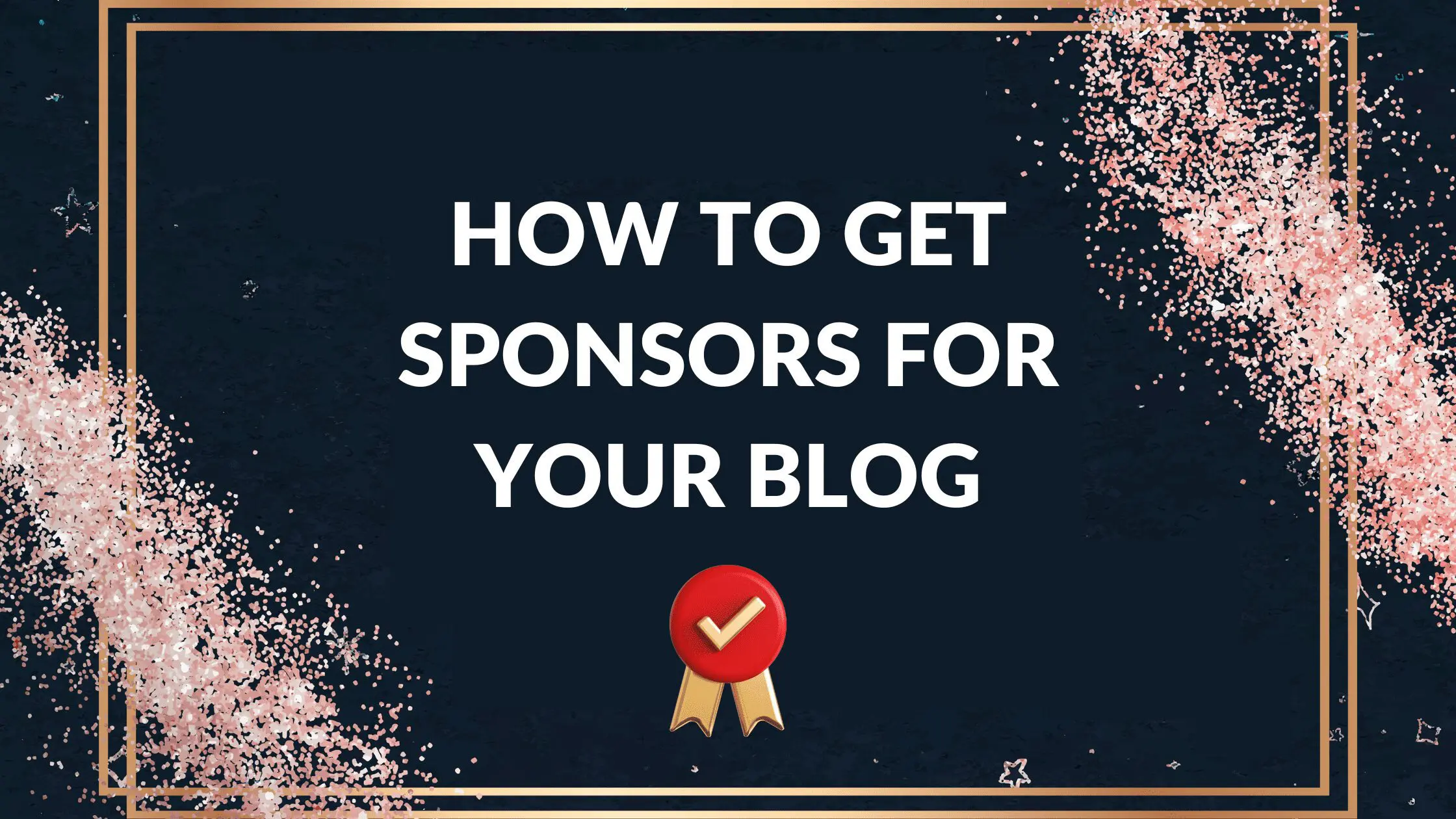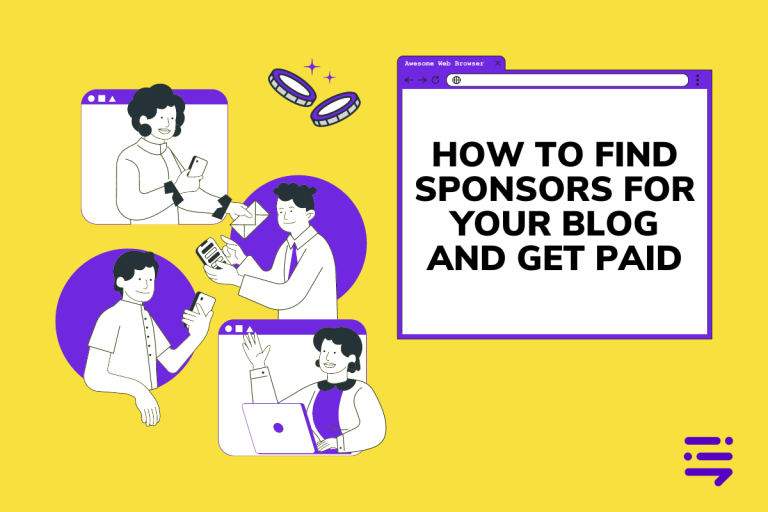To get sponsors for your blog, create high-quality content and build a strong, engaged audience. Reach out to potential sponsors directly with a compelling pitch.
Securing sponsors for your blog can significantly boost your income and credibility. High-quality content attracts more readers, which in turn appeals to potential sponsors. A strong, engaged audience demonstrates that your blog has influence and reach. Directly contacting potential sponsors with a well-crafted pitch shows professionalism and initiative.
Emphasize the benefits they will receive by partnering with you, such as increased brand visibility and access to your loyal audience. Building these relationships can lead to long-term sponsorships and greater financial stability for your blog.

Credit: bloggingguide.com
Identify Potential Sponsors
Getting sponsors for your blog can be a game-changer. Identifying potential sponsors is crucial for monetization. You need to find brands that align with your content.
Research Relevant Brands
Start by researching brands in your niche. Look for companies that share your audience. Use tools like Google and social media platforms.
- Search for brands that promote similar content.
- Check their engagement levels on social media.
- Visit their websites to understand their mission.
Compile a list of these brands. Use a spreadsheet to keep track. Include their contact details and social media handles.
| Brand Name | Website | Contact Email | Social Media |
|---|---|---|---|
| Brand A | www.brand-a.com | contact@brand-a.com | @brand_a |
| Brand B | www.brand-b.com | contact@brand-b.com | @brand_b |
Analyze Competitor Partnerships
Look at your competitors’ blogs. Identify who their sponsors are. This can give you a head start.
Make a list of these sponsors. Analyze their sponsorship terms. Check their engagement with the competitor’s audience.
- Visit competitor blogs.
- Identify their sponsors.
- Analyze sponsorship terms and audience engagement.
Use this information to approach these sponsors. Highlight your unique selling points. Explain how you can provide value to them.

Credit: sharinglifesmoments.com
Create A Media Kit
Creating a media kit is crucial for getting sponsors for your blog. A media kit serves as a resume for your blog, showcasing your strengths and potential. It provides sponsors with all the information they need to make an informed decision. This section will guide you on how to create an effective media kit.
Highlight Key Metrics
Sponsors want to see the performance of your blog. Highlight key metrics that show your blog’s success.
- Monthly Page Views: Display your average monthly page views.
- Unique Visitors: Show the number of unique visitors your blog receives.
- Social Media Followers: Include your follower count on platforms like Facebook, Twitter, and Instagram.
- Email Subscribers: Mention the number of people subscribed to your newsletter.
Use a table to present these metrics clearly:
| Metric | Value |
|---|---|
| Monthly Page Views | 50,000 |
| Unique Visitors | 20,000 |
| Social Media Followers | 10,000 |
| Email Subscribers | 5,000 |
Showcase Audience Demographics
Understanding your audience is essential for sponsors. Showcase audience demographics to help sponsors see the value of partnering with your blog.
- Age Range: Indicate the average age range of your readers.
- Gender Distribution: Show the percentage of male and female readers.
- Location: Mention the countries or regions where most of your readers are located.
- Interests: Highlight the common interests and hobbies of your audience.
Present this information in a clear and concise manner:
| Demographic | Details |
|---|---|
| Age Range | 18-35 years |
| Gender Distribution | 60% Female, 40% Male |
| Location | USA, UK, Canada |
| Interests | Travel, Fashion, Technology |
These details help sponsors understand if your blog aligns with their target audience. Making your media kit comprehensive and attractive can increase your chances of securing sponsorships.
Craft A Compelling Pitch
To attract sponsors to your blog, you must craft a compelling pitch. This pitch should highlight your blog’s strengths and unique qualities. A well-structured pitch can make your blog stand out. Let’s dive into how to create a pitch that gets noticed.
Personalize Your Approach
Always personalize your approach when reaching out to sponsors. Address them by their name. Show that you’ve done your homework on their brand. Mention specific products or services they offer.
Use a friendly and professional tone. Avoid generic messages. Make your pitch feel tailored just for them.
Include how their brand aligns with your blog. This shows a mutual benefit. Sponsors appreciate a personal touch.
Focus On Value Proposition
Your pitch should clearly state your value proposition. Explain what you can offer the sponsor. Highlight your blog’s audience and engagement rates.
Use bullet points to list key benefits:
- High traffic volume
- Engaged audience
- Targeted demographics
Provide statistics to back your claims. Use Google Analytics or other tools. Include metrics like page views and social media followers.
Here is a sample data table to present your blog’s key metrics:
| Metric | Value |
|---|---|
| Monthly Page Views | 50,000+ |
| Email Subscribers | 10,000+ |
| Social Media Followers | 20,000+ |
Show how these metrics can benefit the sponsor. For example, more visibility and potential sales. This makes your pitch more attractive.
Leverage Social Proof
Social proof is a powerful tool to attract sponsors for your blog. Sponsors need to trust your blog and its influence. Showcasing social proof can build that trust effectively. Let’s explore two main ways to leverage social proof: share testimonials and highlight previous collaborations.
Share Testimonials
Testimonials from satisfied partners can boost your credibility. Ask previous sponsors for feedback. Display their testimonials prominently on your blog. Here’s a simple way to structure them:
| Sponsor | Testimonial |
|---|---|
| Brand X | “This blog helped us reach our target audience effectively.” |
| Brand Y | “Great collaboration and impressive results.” |
Include the sponsor’s logo for visual impact. Positive testimonials build trust and show your blog’s value.
Highlight Previous Collaborations
Highlighting past collaborations with well-known brands is crucial. It shows that other companies trust your blog. Use the following format to present them:
- Brand A: Partnered for a month-long campaign.
- Brand B: Sponsored a series of posts.
- Brand C: Collaborated for a product launch.
Provide details of the collaboration. Mention the type of content created and the results achieved. For example:
- Brand A: Increased their website traffic by 20%.
- Brand B: Boosted their social media engagement by 15%.
- Brand C: Successfully launched a new product line.
Using detailed examples helps potential sponsors see the benefits of working with you. They can visualize similar success for their brand.
Negotiate And Close Deals
Getting sponsors for your blog is an exciting step. The negotiation and closing stage is crucial. This part determines the partnership’s success. You need clear strategies to succeed. Here are some essential tips.
Set Clear Expectations
Setting clear expectations is vital. Communicate your blog’s value to potential sponsors. Share your audience demographics and engagement metrics. This data shows your blog’s reach and influence.
Define what you offer. This includes ad placements, sponsored posts, and social media mentions. Be clear about your deliverables and timelines. Transparency builds trust and sets a positive tone.
Outline your sponsorship packages. Detail the benefits sponsors receive. Offer statistics to back your claims. This helps sponsors see the value in your blog.
Here’s an example table of deliverables:
| Deliverable | Details | Timeline |
|---|---|---|
| Sponsored Blog Post | 500-word article with backlinks | 1 week |
| Social Media Mention | Instagram post and story | 3 days |
| Banner Ad | Sidebar placement for 1 month | 1 day |
Offer Flexible Packages
Offer flexible packages to attract diverse sponsors. Tailor packages to fit different budgets. This makes your blog accessible to more companies.
Create basic, standard, and premium packages. Each package should offer varying levels of exposure. List the features and benefits of each. This helps sponsors choose what fits their needs.
- Basic Package: One sponsored post, one social media mention.
- Standard Package: Two sponsored posts, two social media mentions, one banner ad.
- Premium Package: Four sponsored posts, four social media mentions, two banner ads.
Be open to custom packages. Some sponsors may have unique needs. Adapt your offerings to meet these requests. Flexibility can lead to more deals.
Follow these tips for effective negotiation. Closing deals becomes smoother. Your blog grows, and sponsors benefit. It’s a win-win for everyone.

Credit: www.nichepursuits.com
Frequently Asked Questions
How To Get Sponsorships For Your Blog?
To get sponsorships for your blog, create quality content, build a strong audience, and engage with potential sponsors. Share your blog’s analytics and audience demographics. Reach out to brands directly and network with other bloggers.
Do Bloggers Get Sponsored?
Yes, bloggers often get sponsored. Brands pay them to promote products or services through blog posts, social media, and reviews.
How Do I Get Companies To Sponsor Me?
To get companies to sponsor you, create a compelling pitch, highlight your audience, offer mutual benefits, and build relationships.
How Much Do Sponsors Pay Bloggers?
Sponsors typically pay bloggers $50 to $5,000 per post. Payment depends on the blogger’s niche, audience size, and engagement rate.
How Can I Attract Blog Sponsors?
Create valuable content, grow your audience, and engage consistently. Use social media to increase visibility.
Conclusion
Securing sponsors for your blog requires effort and strategy. Build strong relationships and showcase your blog’s value. Consistently engage with potential sponsors and present a professional image. Stay patient and persistent to achieve success. By following these tips, you can attract sponsors and grow your blog effectively.


